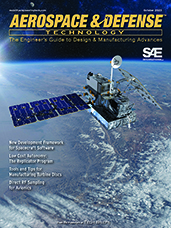Aerospace & Defense Technology
October 2023
- DoD to Deploy Thousands of Low Cost Autonomous Systems Under Replicator Program
- Top Productivity Improvement Tips for Manufacturing Turbine Discs
- FACE Technical Standard Offers MOSA Lessons for Safety-Critical Software in Any Sector
- Adamant: A Soon-to-be Open Source, Mission-Critical Flight Software Framework Written in Ada
- Benefits and Challenges of Direct-RF Sampling for Avionic Platforms
- More Airports Test RF as Counter Measure for UAS in Restricted Airspace
- Adapting U.S. Army Acquisition to Ensure the Reliability and Safety of Autonomous Vehicles
This report presents several challenges that the U.S. Army will face in the transition to autonomous vehicles, challenges that are only magnified in the current acquisition environment with limited testing. Artificial intelligence algorithms introduce additional complexity, resulting in systems with a complex combination of human, machine, and autonomous controllers. - An Adaptive Pipeline From Scientific Data to Models
Under DARPA's Synergistic Discovery and Design program, a team composed of scientists from Duke, Rutgers, Montana State, and Florida Atlantic Universities, as well as Geometric Data Analytics, and Netrias, Inc., broadly researched and developed data driven techniques for scientific discovery and robust design, proving feasibility through program challenge problems with Yeast States, Novel Chassis, Protein Stability, and Perovskite. - A Simpler Method for Learning to Control a Robot
Researchers develop a machine-learning technique that can efficiently learn to control a robot, leading to better performance with fewer data. - Learning Defects From Aircraft NDT Data
Non-destructive evaluation of aircraft production is optimized and digitalized with Industry 4.0. The aircraft structures produced using fiber metal laminate are traditionally inspected using water-coupled ultrasound scans and manually evaluated.
Related Topics:

